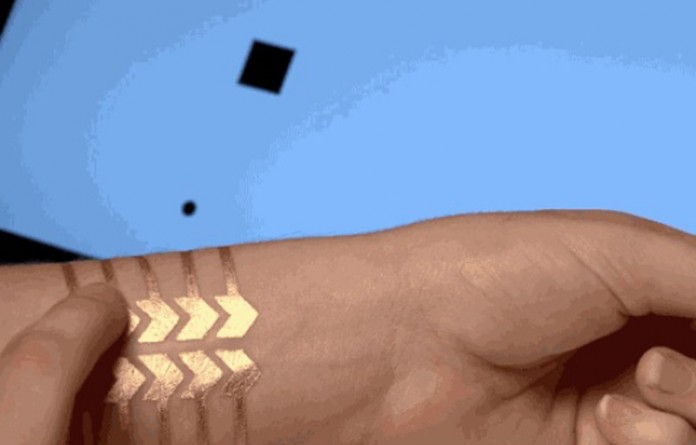Scientists have created a new kind of high-tech temporary tattoo that can act as a controller for smartphone apps and other devices. Called DuoSkin, the tattoos were created as a joint effort between MIT researchers and Microsoft Research. The temporary tattoos are applied just like any other temporary tattoo. Made of gold leaf (and sometimes LEDs) the tattoos look more like jewelry than the temporary tattoos of decades past. In a paper that will be presented at the upcoming International Symposium on Wearable Computers, the researchers outline three main uses for the tattoos: an input device, so you can control, say, a smartphone app; an output device, so the tattoo itself can be used as a display; or a communication device, when the tattoos use NFC (near-field communication) to send data to other devices.
Let’s start with the input example. Think of the input device as kind of touchscreen or trackpad. The idea is similar to Google’s Project Jacquard (which embed sensors into clothing to create “wearable” touchpads.) But with DuoSkin, the sensors are embedded within the tattoos. This allows them to connect to a computer or smartphone so you can control apps by swiping on the tattoo.
The researchers built a prototype in which the tattoo (MIT’s paper describes it a as “skin bracelet,” which may be the most unappealing description of this) is connected to an Arduino computer, which is paired to a smartphone music app. By swiping on the tattoo, the wearer can control the music playback on the app.
DuoSkin is also able to act as an output device, with the tattoos actually displaying information. The MIT and Microsoft researchers demonstrated this with an app for couples called “Couple Harmony” that allowed couples to share their feelings via the tattoos. One person wore a “mood button” on their arm, and pressed it when they felt angry. Pressing the mood button caused the other person’s flame-shaped tattoo to light up (it had built-in LEDs) and glow white, so they could see when their partner was angry.
Similarly, the scientists also created a tattoo that would glow either red or white based on the wearer’s current body temperature. Finally, the researchers built an NFC-enabled version of the tattoos that allowed them to exchange information by tapping a smartphone on the tattoo. In the prototype they created, researchers could share their “skin status” via smartphone app when someone tapped their phone on the tattoo, but the method could be used to share just about any type of information. (Notably, other companies, including Google, have experimented with NFC-enabled temporary tattoos in the past.)
For more news visit:


